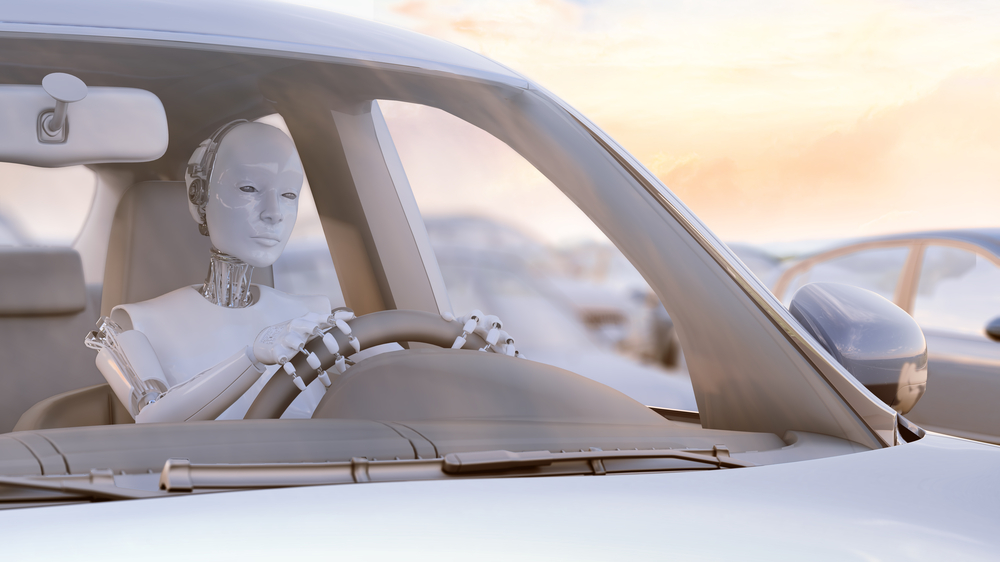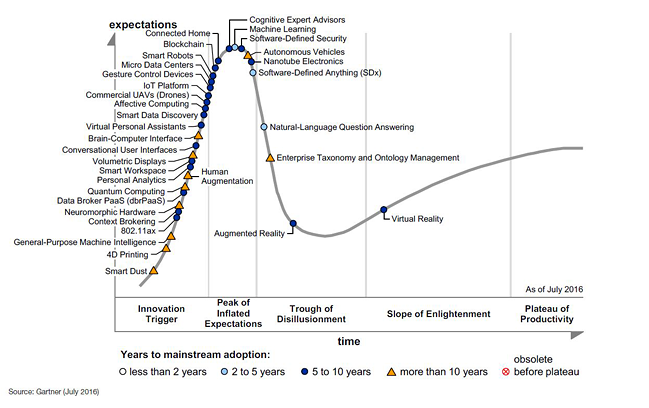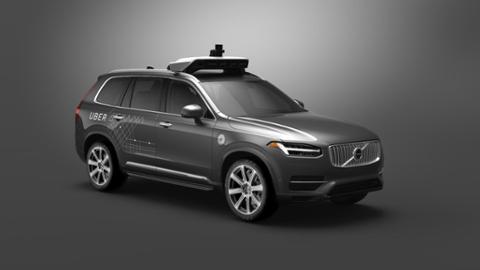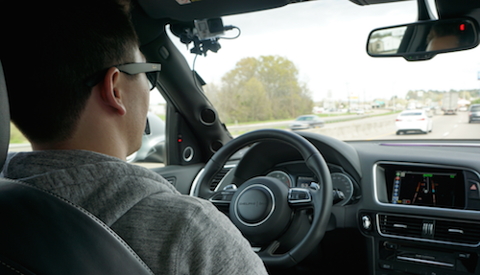
Research firm Gartner
periodically releases a “Hype Cycle,” in which it attempts to show which technologies are just emerging, and which have plateaued. This year, its hype cycle highlights three technologies in particular: “transparently immersive experiences” (i.e., virtual- and augmented-reality systems), “the perceptual smart machine age” (hello, Internet of Things), and “the platform revolution” (i.e., apps, lots of apps). Gartner releases the “Hype Cycle” as a way for tech pros—including chief innovation officers, startup founders, and developers—to keep an eye on those technologies that haven’t quite reached the mainstream-adoption stage, but will nonetheless prove critical to many businesses over the next several years. The Cycle includes four stages:
The Innovation Trigger When technologies emerge from the lab and start becoming popular.
The Peak of Inflated Expectations In other words, when companies want to adopt said technologies.
The Trough of Disillusionment Companies realize technologies won’t solve all their issues.
The Slope of Enlightenment “Hey, we can use this after all!”
Plateau of Productivity When a technology achieves full integration into industry and society. Like so:

In Gartner’s estimation, technologies such as general-purpose machine intelligence and quantum computing are in the Innovation Trigger stage; software-defined security and self-driving vehicles are at the Peak of Inflated Expectations; augmented reality has hit the Trough of Disillusionment; and virtual reality has started the climb up the Slope of Enlightenment. At least this go-round, no technology has reached the nirvana of the Plateau of Productivity. Gartner believes the combination of increasingly powerful processors, massive amounts of data, and interoperability between hardware and software ecosystems is accelerating the scope and power of many technologies. For example, “smart machine” technology will, if things go according to plan, unleash everything from commercial droves and natural-language question answering to “smart dust” that can detect even small changes in the environment. Whether early-stage technologies will pan out, though, remains to be seen. In the meantime, Gartner’s list is well worth your review, if only to compare its vision of the future with your own.
 Research firm Gartner periodically releases a “Hype Cycle,” in which it attempts to show which technologies are just emerging, and which have plateaued. This year, its hype cycle highlights three technologies in particular: “transparently immersive experiences” (i.e., virtual- and augmented-reality systems), “the perceptual smart machine age” (hello, Internet of Things), and “the platform revolution” (i.e., apps, lots of apps). Gartner releases the “Hype Cycle” as a way for tech pros—including chief innovation officers, startup founders, and developers—to keep an eye on those technologies that haven’t quite reached the mainstream-adoption stage, but will nonetheless prove critical to many businesses over the next several years. The Cycle includes four stages: The Innovation Trigger When technologies emerge from the lab and start becoming popular. The Peak of Inflated Expectations In other words, when companies want to adopt said technologies. The Trough of Disillusionment Companies realize technologies won’t solve all their issues. The Slope of Enlightenment “Hey, we can use this after all!” Plateau of Productivity When a technology achieves full integration into industry and society. Like so:
Research firm Gartner periodically releases a “Hype Cycle,” in which it attempts to show which technologies are just emerging, and which have plateaued. This year, its hype cycle highlights three technologies in particular: “transparently immersive experiences” (i.e., virtual- and augmented-reality systems), “the perceptual smart machine age” (hello, Internet of Things), and “the platform revolution” (i.e., apps, lots of apps). Gartner releases the “Hype Cycle” as a way for tech pros—including chief innovation officers, startup founders, and developers—to keep an eye on those technologies that haven’t quite reached the mainstream-adoption stage, but will nonetheless prove critical to many businesses over the next several years. The Cycle includes four stages: The Innovation Trigger When technologies emerge from the lab and start becoming popular. The Peak of Inflated Expectations In other words, when companies want to adopt said technologies. The Trough of Disillusionment Companies realize technologies won’t solve all their issues. The Slope of Enlightenment “Hey, we can use this after all!” Plateau of Productivity When a technology achieves full integration into industry and society. Like so:  In Gartner’s estimation, technologies such as general-purpose machine intelligence and quantum computing are in the Innovation Trigger stage; software-defined security and self-driving vehicles are at the Peak of Inflated Expectations; augmented reality has hit the Trough of Disillusionment; and virtual reality has started the climb up the Slope of Enlightenment. At least this go-round, no technology has reached the nirvana of the Plateau of Productivity. Gartner believes the combination of increasingly powerful processors, massive amounts of data, and interoperability between hardware and software ecosystems is accelerating the scope and power of many technologies. For example, “smart machine” technology will, if things go according to plan, unleash everything from commercial droves and natural-language question answering to “smart dust” that can detect even small changes in the environment. Whether early-stage technologies will pan out, though, remains to be seen. In the meantime, Gartner’s list is well worth your review, if only to compare its vision of the future with your own.
In Gartner’s estimation, technologies such as general-purpose machine intelligence and quantum computing are in the Innovation Trigger stage; software-defined security and self-driving vehicles are at the Peak of Inflated Expectations; augmented reality has hit the Trough of Disillusionment; and virtual reality has started the climb up the Slope of Enlightenment. At least this go-round, no technology has reached the nirvana of the Plateau of Productivity. Gartner believes the combination of increasingly powerful processors, massive amounts of data, and interoperability between hardware and software ecosystems is accelerating the scope and power of many technologies. For example, “smart machine” technology will, if things go according to plan, unleash everything from commercial droves and natural-language question answering to “smart dust” that can detect even small changes in the environment. Whether early-stage technologies will pan out, though, remains to be seen. In the meantime, Gartner’s list is well worth your review, if only to compare its vision of the future with your own. 


